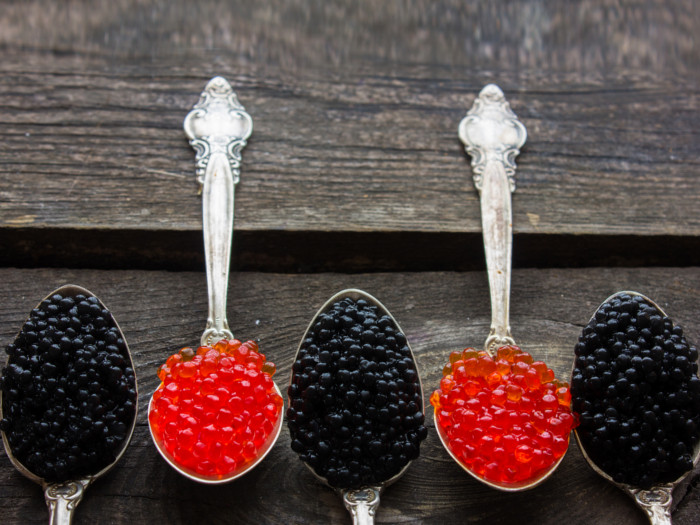Caviar is a globally renowned type of sea dish that has numerous health benefits. There is a wide variety of caviar to choose from. Let’s take a look at it in detail below.
What is Caviar?
A worldwide delicacy, caviar consists of ‘roe’ – a mass of small and delicate fish eggs. Traditionally, caviar is made from the eggs of sturgeon. In most commercial productions of this delicacy, the roe is extracted from a stunned female fish and then cured in salt. The soft and popping texture of the egg is considered a unique selling point of this luxurious dish. Salt and seaweed are the dominant flavors of caviar, but fresher varieties are less salty; the less salty it is, the more expensive it will be. Both the complicated extraction method and the short lifespan of caviar account for its high cost. Caviar is considered to be a good source for a range of vitamins and minerals such as vitamins A, B6, B12, and E, as well as iron, magnesium, and selenium. [1]
Types
There are many different types of caviar available in the market including beluga, sterlet, Kaluga hybrid, ossetra, American ossetra, Siberian sturgeon, and sevruga. Let us take a look at them below.

Caviar is a delicacy used as a garnish or spread. Photo Credit: Shutterstock
- Beluga: This rarely caught fish produces generous-sized grey to black roe which is creamy and soft in flavor. The rarity of the fish places this caviar at the higher end of the price spectrum.
- Sterlet: The roe from Sterlet Sturgeon are small and rich with a strong flavor.
- Kaluga Hybrid: An ecologically minded alternative to Beluga, this fish is farm-raised and produces roe with similarly buttery characteristics to the Beluga roe. [2]
- Ossetra: Obtained from the Ossetra sturgeon and colored deep brown to warm gold, this caviar consists of medium-sized eggs and offers a fruity flavor.
- American Ossetra: American ossetra are farm-raised, with the aim of preserving wild sturgeon and reducing the cost of caviar.
- Siberian Sturgeon: A large, firm variety of this delicacy that has a nutty flavor and colors ranging from light brown to black.
- Sevruga: This species produces small roe with a salty, rich taste. The fish that produces this roe are more plentiful than other sturgeons, and the price is therefore lower.
Serving Size : Nutrient Value Water [g] 47.5 Energy 264 Energy [kJ] 1105 Protein [g] 24.6 Total lipid (fat) [g] 17.9 Ash [g] 6.5 Carbohydrate, by difference [g] 4 Calcium, Ca [mg] 275 Iron, Fe [mg] 11.88 Magnesium, Mg [mg] 300 Phosphorus, P [mg] 356 Potassium, K [mg] 181 Sodium, Na [mg] 1500 Zinc, Zn [mg] 0.95 Copper, Cu [mg] 0.11 Manganese, Mn [mg] 0.05 Selenium, Se [µg] 65.5 Thiamin [mg] 0.19 Riboflavin [mg] 0.62 Niacin [mg] 0.12 Pantothenic acid [mg] 3.5 Vitamin B-6 [mg] 0.32 Folate, total [µg] 50 Folate, food [µg] 50 Folate, DFE [µg] 50 Choline, total [mg] 490.9 Vitamin B-12 [µg] 20 Vitamin A, RAE [µg] 271 Retinol [µg] 271 Vitamin A, IU [IU] 905 Lutein + zeaxanthin [µg] 648 Vitamin E (alpha-tocopherol) [mg] 1.89 Vitamin D (D2 + D3), International Units [IU] 117 Vitamin D (D2 + D3) [µg] 2.9 Vitamin D3 (cholecalciferol) [µg] 2.9 Vitamin K (phylloquinone) [µg] 0.6 Fatty acids, total saturated [g] 4.06 14:0 [g] 0.21 16:0 [g] 3.56 18:0 [g] 0.29 Fatty acids, total monounsaturated [g] 4.63 16:1 [g] 1.04 18:1 [g] 3.17 20:1 [g] 0.31 22:1 [g] 0.11 Fatty acids, total polyunsaturated [g] 7.41 18:2 [g] 0.08 18:3 [g] 0.02 18:4 [g] 0.03 20:4 [g] 0.51 20:5 n-3 (EPA) [g] 2.74 22:5 n-3 (DPA) [g] 0.23 22:6 n-3 (DHA) [g] 3.8 Cholesterol [mg] 588 Tryptophan [g] 0.32 Threonine [g] 1.26 Isoleucine [g] 1.04 Leucine [g] 2.13 Lysine [g] 1.83 Methionine [g] 0.65 Cystine [g] 0.45 Phenylalanine [g] 1.07 Tyrosine [g] 0.97 Valine [g] 1.26 Arginine [g] 1.59 Histidine [g] 0.65 Alanine [g] 1.65 Aspartic acid [g] 2.39 Glutamic acid [g] 3.63 Glycine [g] 0.74 Proline [g] 1.2 Serine [g] 1.9 Sources include : USDA [3]
Benefits
A small amount of caviar can supply the recommended daily amount of vitamin B12 for adults. It promotes circulatory health and boosts immunity, among other benefits. Vitamins B6 and B12 can be hard to find in most fresh foods and have a range of health benefits, such as:
- Helping the development of muscles by storing and metabolizing proteins
- Aiding in regenerating hemoglobin which supports the circulatory system [4]
- Protecting against viruses by supporting a healthy immune system
- Maintaining a healthy nervous system
- Promoting the formation of red blood cells and DNA
- Preventing migraines
It contains a high level of omega-3 fatty acids, which can also provide a number of healthy boosts, including the following: [5]
- Lowering blood pressure
- Preventing heart attacks
- Acting as an antidepressant
- Aiding bone health
It also contains antioxidants, which are essential for maintaining a youthful skin.
How to Eat?
Caviar is to be savored as a delicacy. Let us take a look at the various ways to eat it.
- Take small spoonfuls and let your mouth leisurely experience the taste and texture sensations of the dish.
- It should be served chilled.
- If possible, serve in a glass bowl and provide a non-metal spoon to eat with, so as to best appreciate the flavors.
- Champagne or another high-quality sparkling wine makes a good accompaniment for this dish.
- Eat caviar as a solo dish or add a little toast or cream on the side.
- It can also be used as a garnish or a topping for potatoes.
